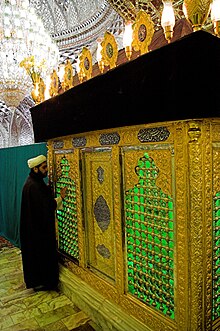Imamzade
Imamzade or Imāmzādeh ( Persian امامزاده, IPA : [ ɛmɑmzɑdɛ ]) is the Persian word for “descendant of an imam”, which means the descendants of the Twelve Imams of the Shiites . This includes both children and grandchildren and their descendants. Sometimes female descendants are honored as Imamzade.
building
The term is also used to describe the shrine or mausoleum in which such a descendant of an imam is buried. Many such building complexes are located in Iran , including Iraq and Afghanistan . Their architecture and interiors are usually very complex. They are mostly Shiite centers and pilgrimage sites for the ziyarat (visit) for the regional population. The Imam Khomeini mausoleum in Tehran can also be characterized as an Imamzade , since he was a Sayyid . The Office for Pious Foundations (Sāzmān-e awqāf) put the number of Imamzades in Persia at 1,059 in 1973.
Allama Majlisi , one of the most famous Shiite scholars from the Safavid period , encourages believers to visit these tombs and buildings. He notes in his pilgrim handbook, Gift for the Pilgrims ( Tuhfatul-Za'er ), among other things, that the blessing is received when visiting the tombs.
literature
- Dwight M. Donaldson : The Shi'ite Religion: A History of Islam in Persia and Irak (= Luzac's Oriental Religions Series . Vol. 6). Luzac & Co., London 1933
- Moojan Momen : An Introduction to Shi'i Islam: The History and Doctrines of Twelver Shi'ism (1985) ( digitized version )
Web links
-
EMĀMZĀDA i-iii , Encyclopædia Iranica Vol. 8/4 (1998), 395-412.
- PARVĪZ VARJĀVAND: EMĀMZĀDA iii. Number, distribution, and important examples , Encyclopædia Iranica Vol. 8/4 (1998), 400-412.
References and footnotes
- ↑ See e.g. B. the articles Fātima bint Mūsā & Shrine of Fatima Masuma
- ↑ iranicaonline.org ( Encyclopædia Iranica )
- ^ Moojan Momen, p. 116
- ↑ cf. The Gift of Pilgrim
- ↑ Majlisi, after Donaldson, p. 258 (in the chapter devoted to pilgrimages to the tombs of the Imamzades with the subheadings : Ḳumm , Shah Abdu'l-Azim , Ardabil in Adherbaijan , Graves of other Imamzadehs.)
